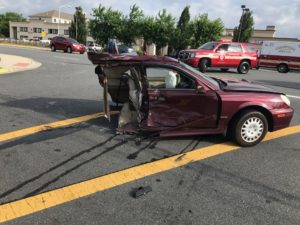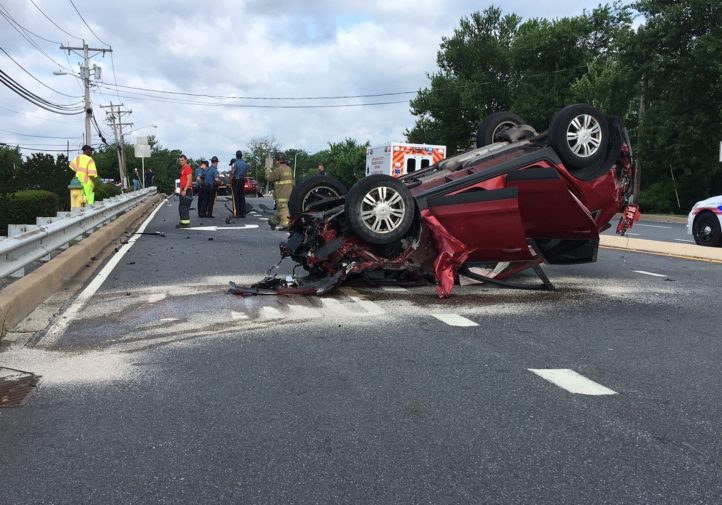
UPDATE: Del. split car raises questions of prior repair — or simply reinforces why best practices matter
By onBusiness Practices | Education | Repair Operations
Dramatic WDEL footage and law enforcement images of a car literally split in half by a collision in Christiana, Del., makes one wonder if the vehicle had ever been repaired before — and if so, was it done correctly?
The bisected vehicle, a 2004 Hyundai Sonata, was attempting to make a left turn while traveling westbound when it was struck on the right side by a 2010 Cadillac SRX traveling eastbound, according to the Delaware State Police.
“The collision caused the rear passenger seats to the rear bumper of the Sonata to be ripped off the vehicle and caused the vehicle to rollover towards the University Plaza parking lot,” DSP public information Director Sgt. Richard Bratz wrote in a news release Monday. “The Cadillac SRX continued to travel forward and started to move to the right and collided with the guard rail and then bounced back into the roadway. The Cadillac SRX began to rollover to its left side still heading eastbound on Chapman Road and rolled over one and half times landing on its top on the south edge of Chapman Road. The Hyundai Sonata was split in half and the rear end rolled over into the University Plaza parking lot. The vehicle’s front end spun clockwise and came to a stop west of University Plaza and south of Chapman Road.”

Fortunately, nobody was seriously hurt. The driver and two children inside the SRX were unharmed, and the Sonata’s driver received only “non-life threatening injuries.”
The SRX driver was cited for alleged unreasonable speed; WDEL reporter Mike Phillips reported that speed limits in the area list maximums of 35 and 45 mph. The Sonata driver was cited for allegedly failing to yield the right of way.
In a Monday morning Facebook video of the incident’s aftermath, Phillips said he was told the back half of the Sonata “flew through the air” and landed about 200 feet backwards in a parking lot.
“Fortunately, no backseat passengers,” he says.
The nature of the collision makes one wonder if the Sonata had in the past been “clipped” — repaired by replacing a damaged portion of the car with an intact portion of a salvage vehicle. Discussion on Facebook by parties with ties to the collision repair industry floats that possibility.
However, a collision damage expert witness said such divisions, while dramatic, do occur regularly on vehicles which haven’t been in a prior crash.
“(It’s) not unusual that (a) vehicle get cut in half during a serious crash,” forensic engineer Jeff Lange, owner of Lange Technical Services, wrote in an email. “I’ve seen it many times.”


A CARFAX report for the Sonata indicates it was in an accident involving “rear impact” in 2010. CARFAX has no records of structural damage, nor does it provide a red flag even indicating collision repair occurred. No other details could be ascertained, and the DSP wouldn’t release records of the June collision to media.
Regardless of if the vehicle was clipped or not, the crash shows the importance of following OEM repair procedures (which generally forbid clipping).
Automakers test their instructions to collision repairers, verifying that following the repair procedures will preserve the vehicle’s structural integrity. A repaired vehicle will behave the way a new vehicle behaves when struck by another car. (Of course, at certain speeds, all bets might be off. For example, neither NHTSA nor IIHS crashworthiness testing exceeds 55 mph.)
Deviate from this proven technique for an untested solution, and you might risk your work failing spectacularly days, months or years later in front of 100,000 Facebook viewers.
As for clipping, I-CAR itself has said to knock it off in favor of whatever the manufacturer says.
“Those old general sectioning guidelines that were developed in the ’80s are not applicable on today’s vehicles,” I-CAR industry technical relations director Jason Bartanen said in an April “Repair University Live.”
Collision Hub ‘Repair U,’ I-CAR: Clipping procedures of 1980s are dead
When clipping procedures were developed in the 1980s, the IIHS small-offset crash test didn’t exist, and the vehicles were made from mild steel, according to Bartanen.
“They shouldn’t be used on today’s vehicles,” he said.
Some smaller-scale sectioning is still possible, but only when OEMs have a procedure, according to Bartanen.
More information:
WDEL Facebook page, June 19, 2017
“‘Crazy’ crash cuts car in half in Christiana”
WDEL, June 19, 2017
“**Update #1** Troopers Investigating Crash-Newark”
Delaware State Police, June 19, 2017
Images:
Images 1-2, gallery, article: Law enforcement images of a Hyundai Sonata literally split in half by a collision in Christiana, Del., makes one wonder if the vehicle had received structural repairs in the past. (Provided by Delaware State Police)
Images 3-5, gallery: WDEL reporter Mike Phillips provided this image of a Hyundai Sonata literally split in half by a collision in Christiana, Del. (Mike Phillips/WDEL)





